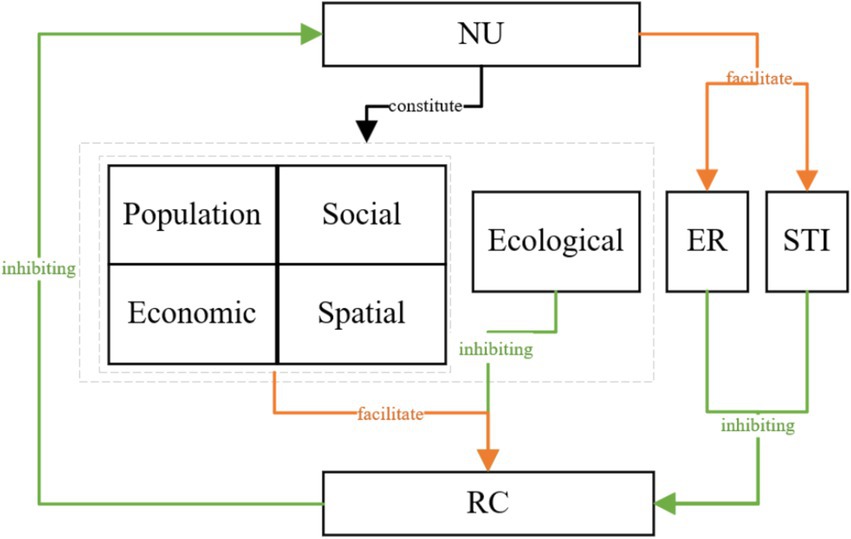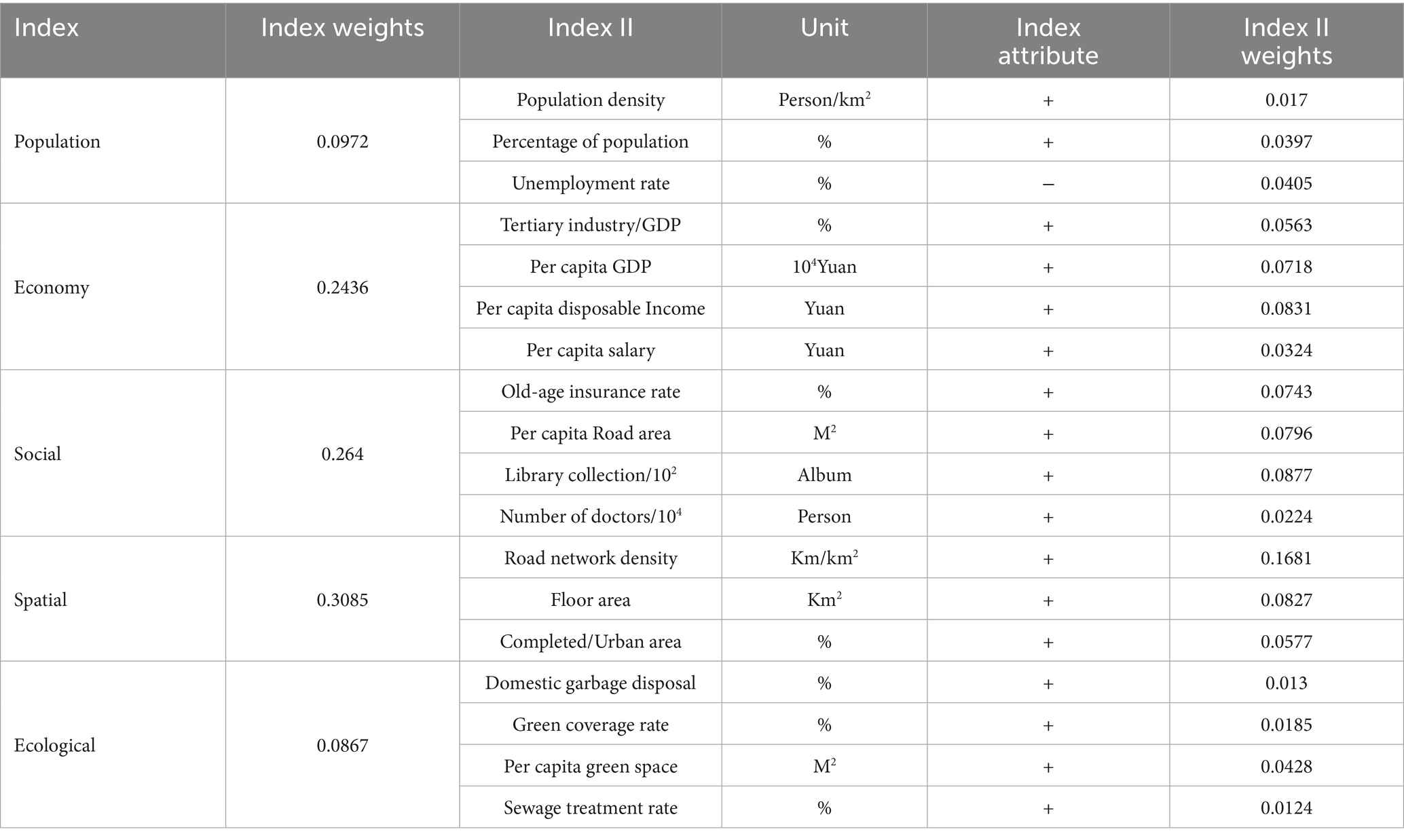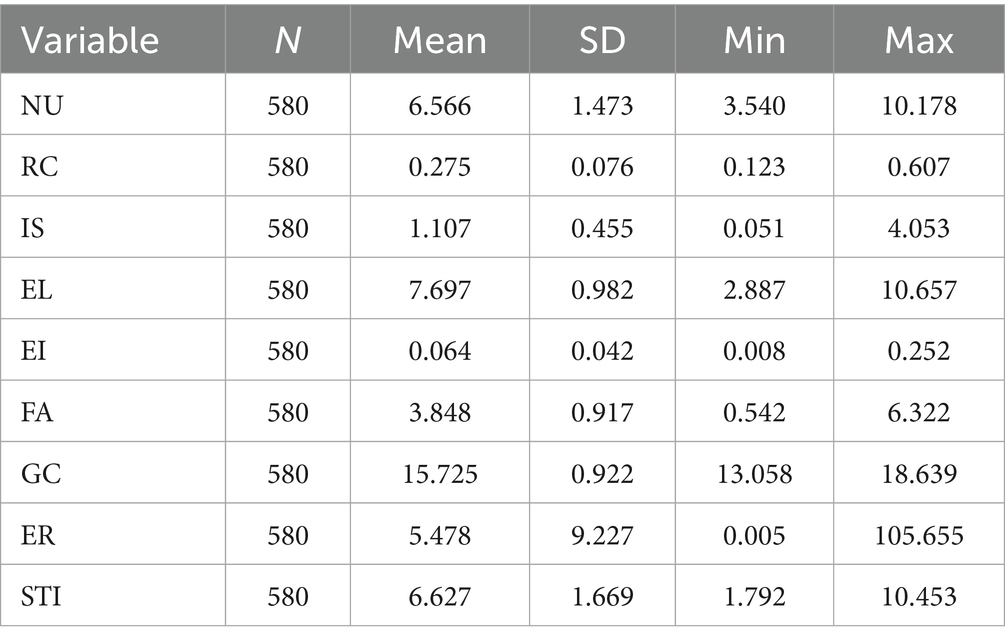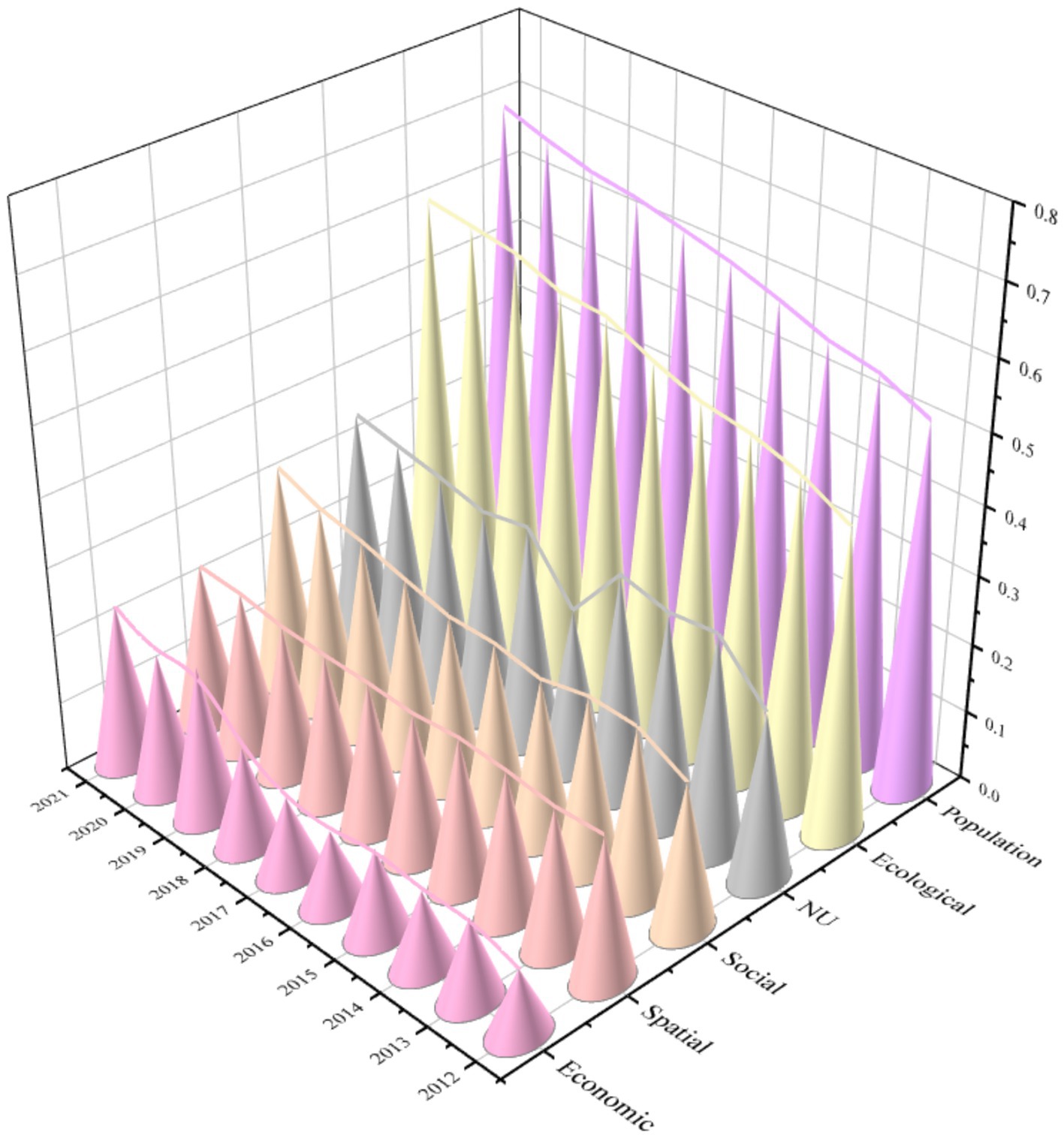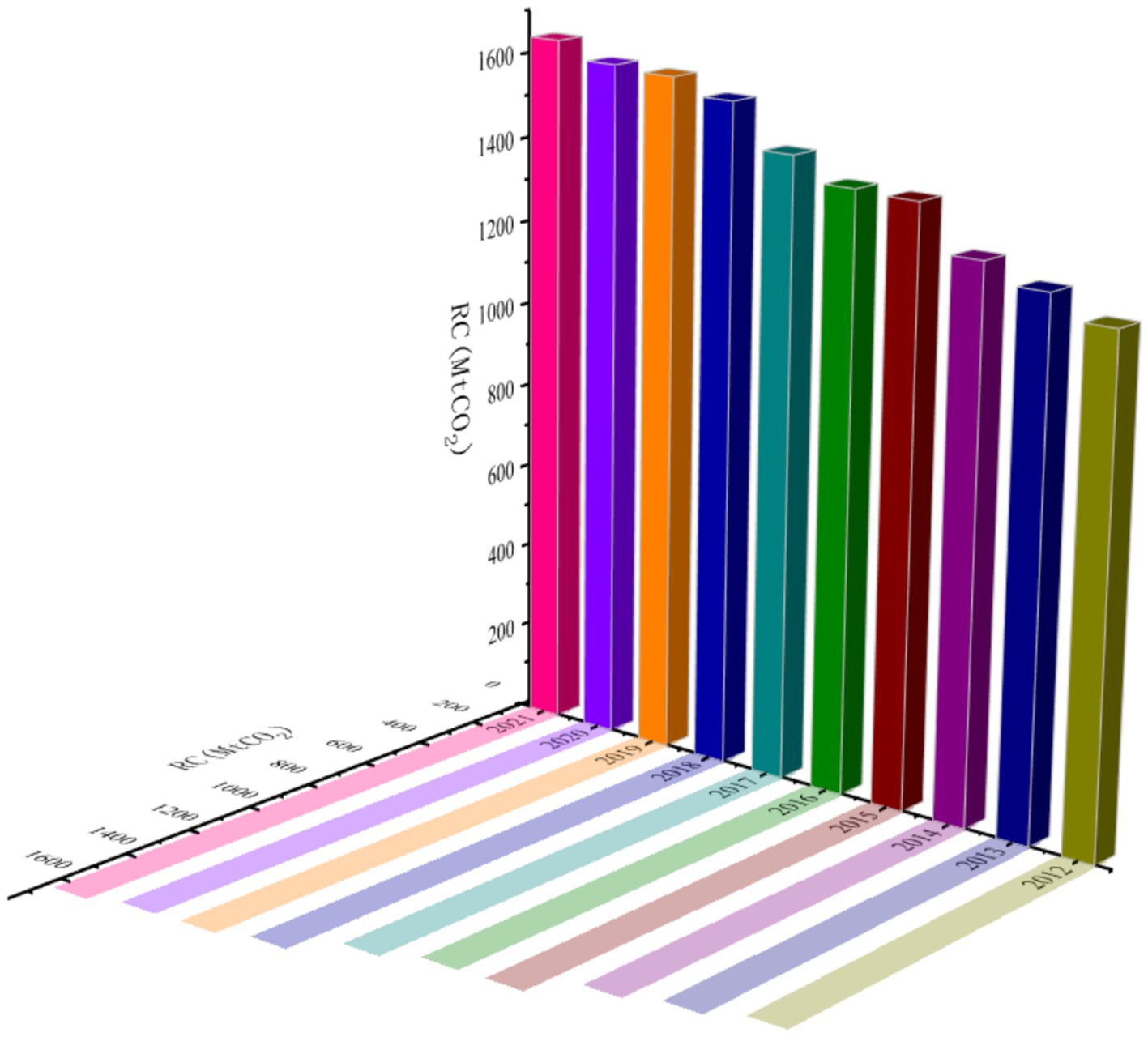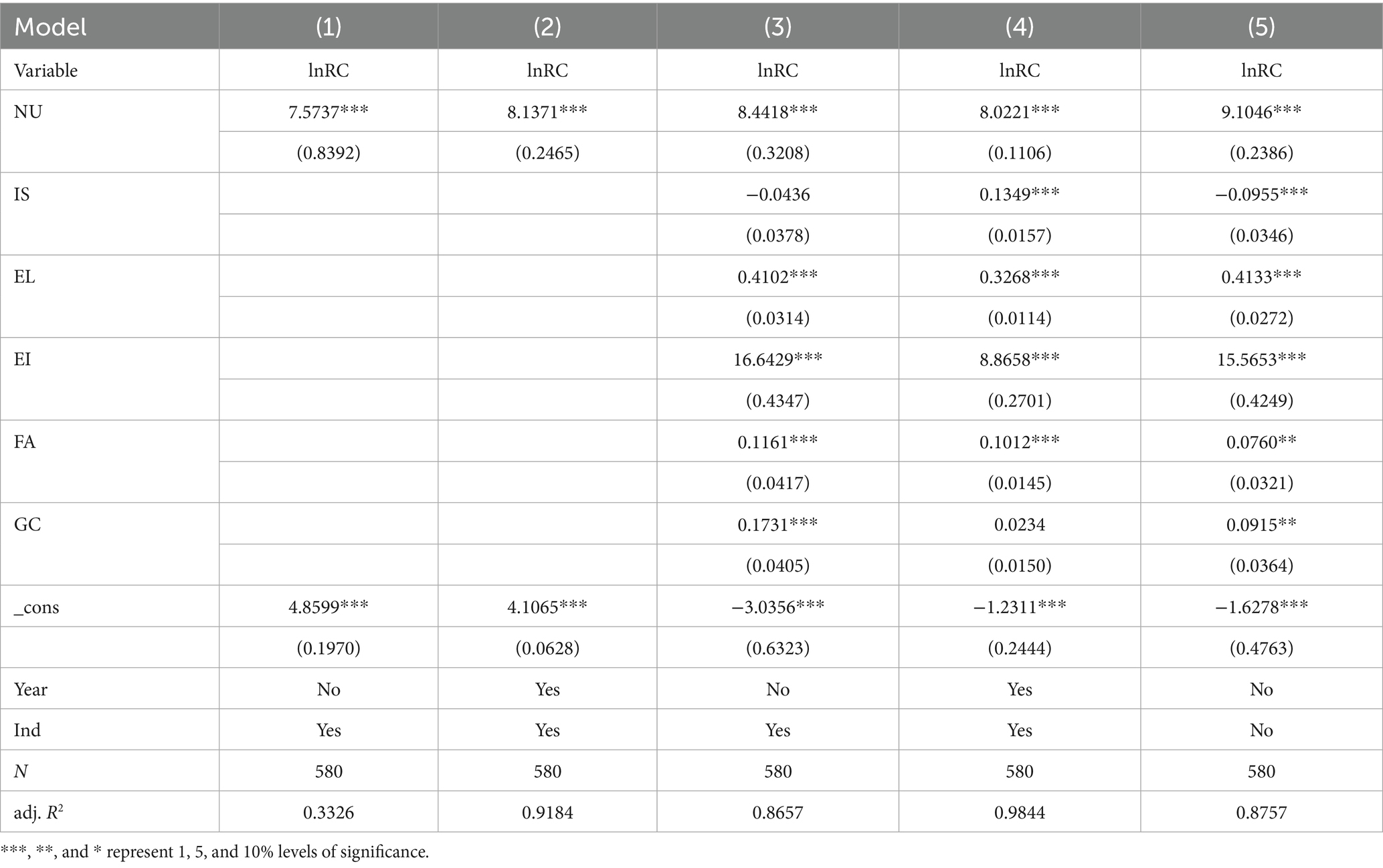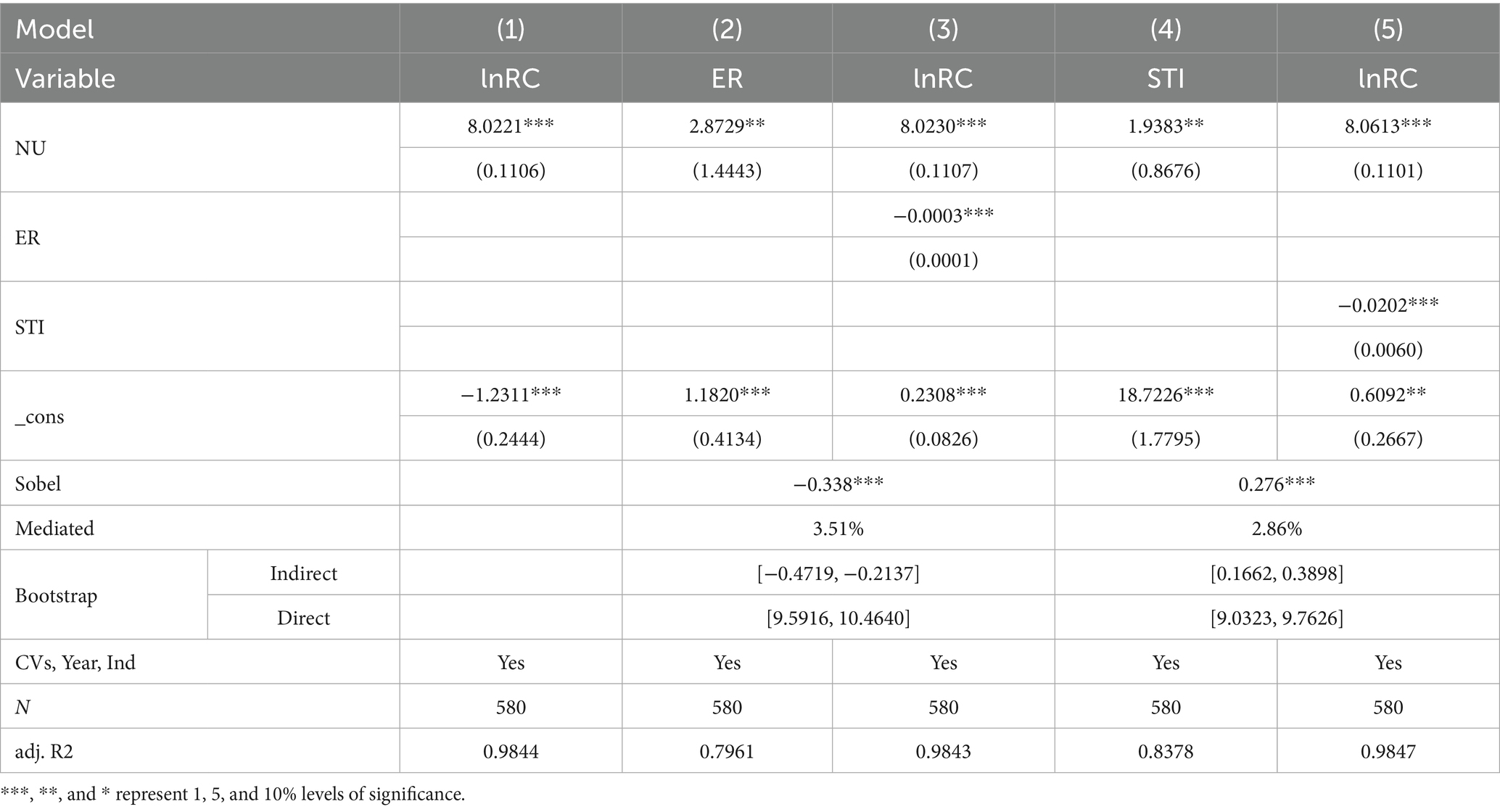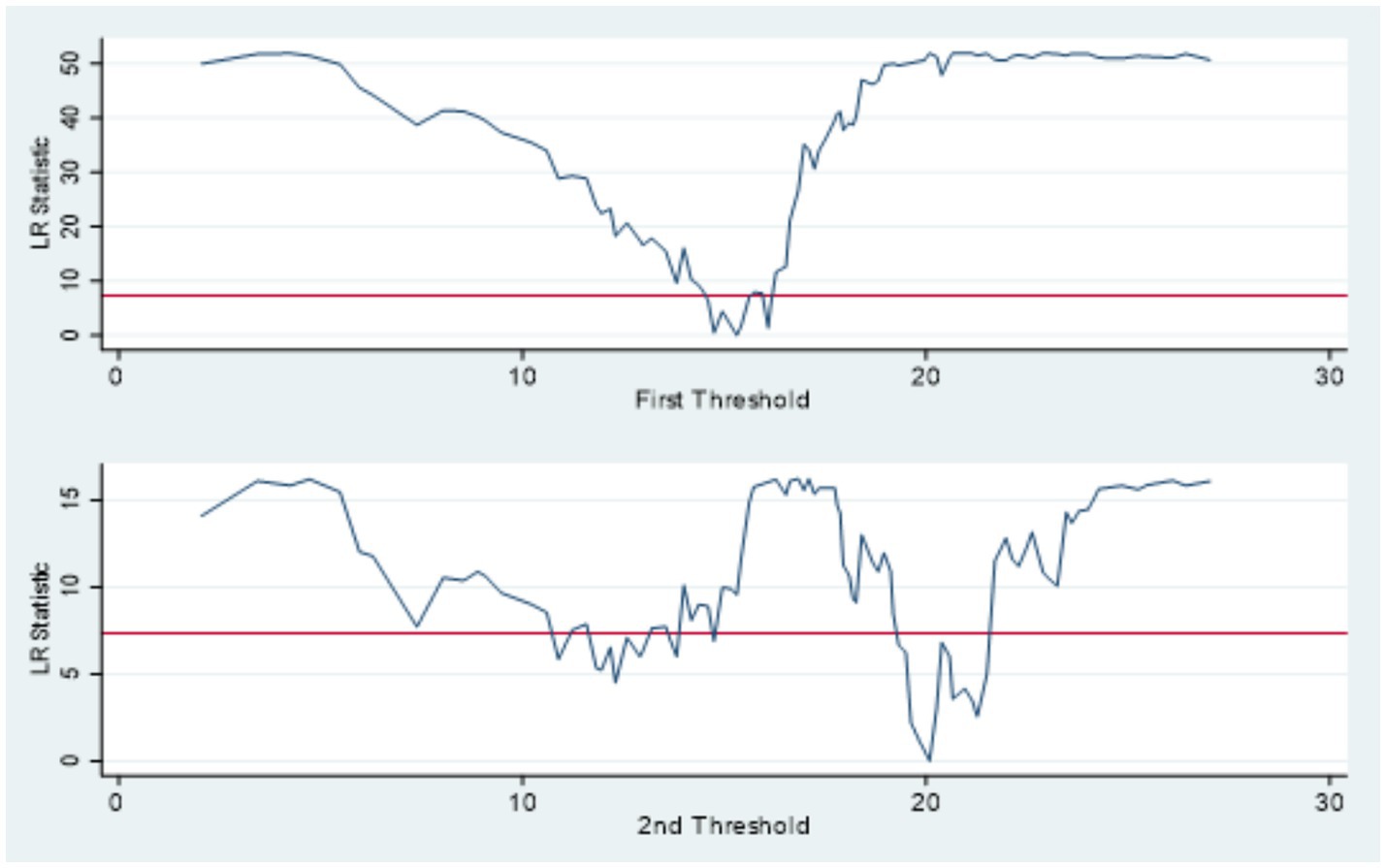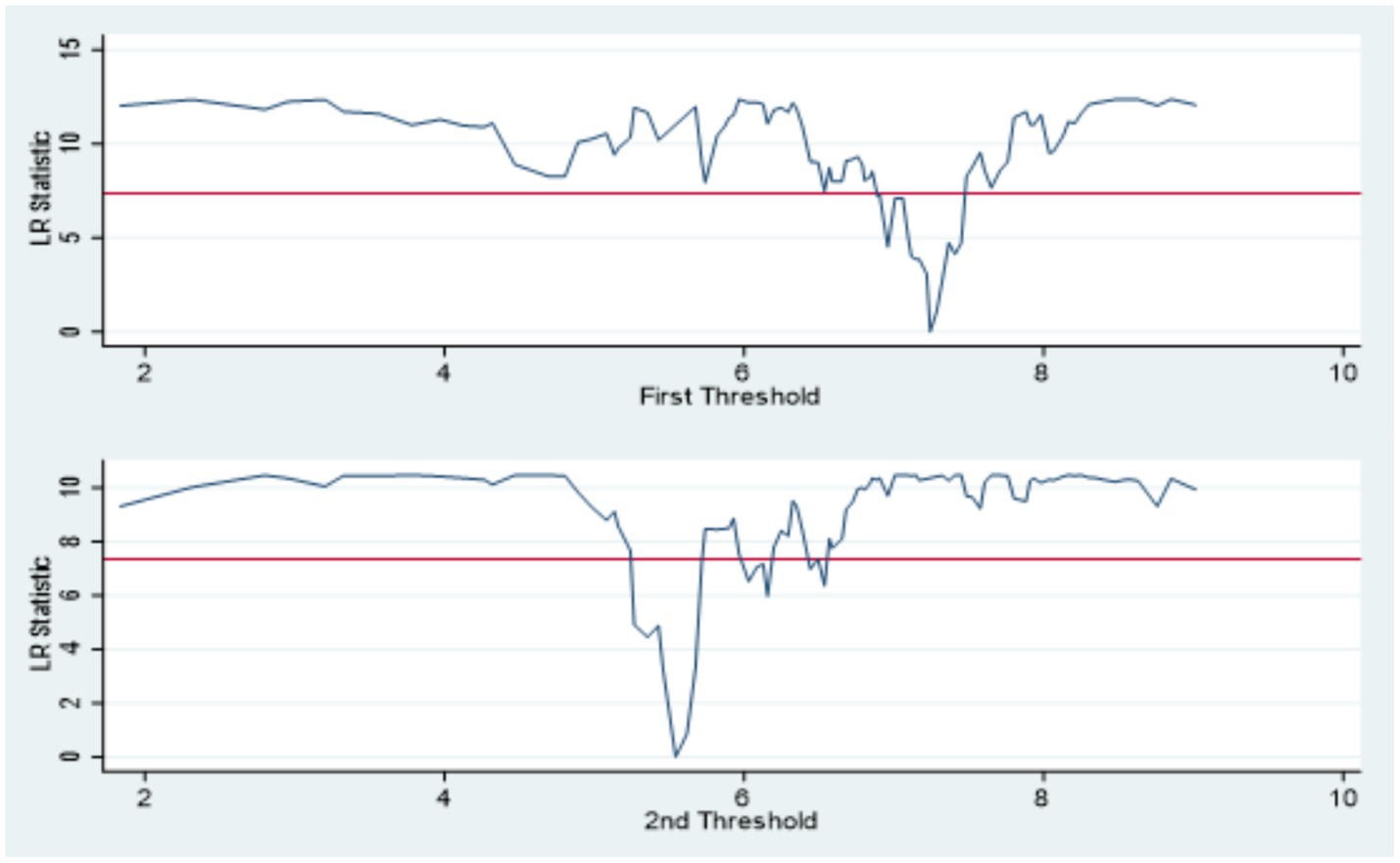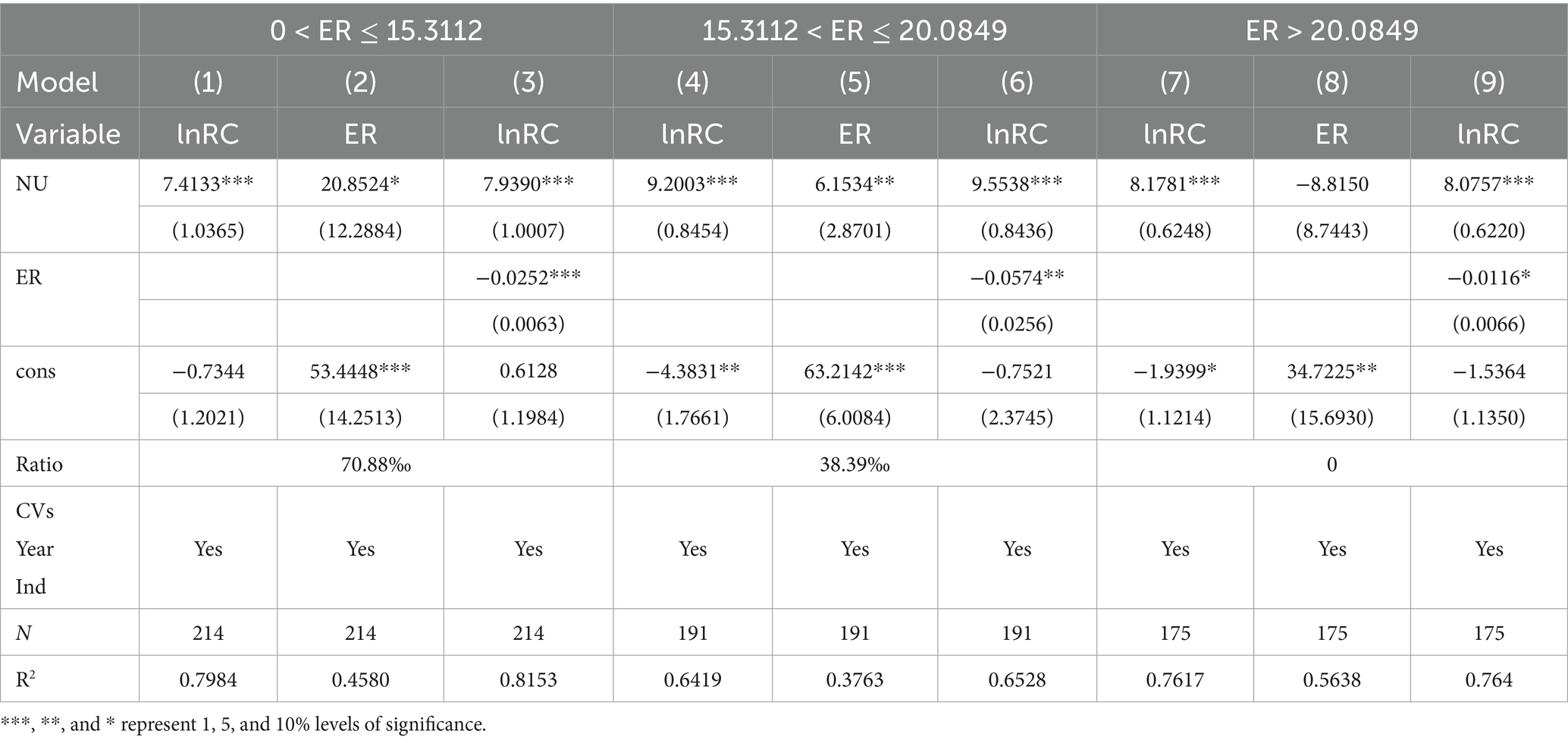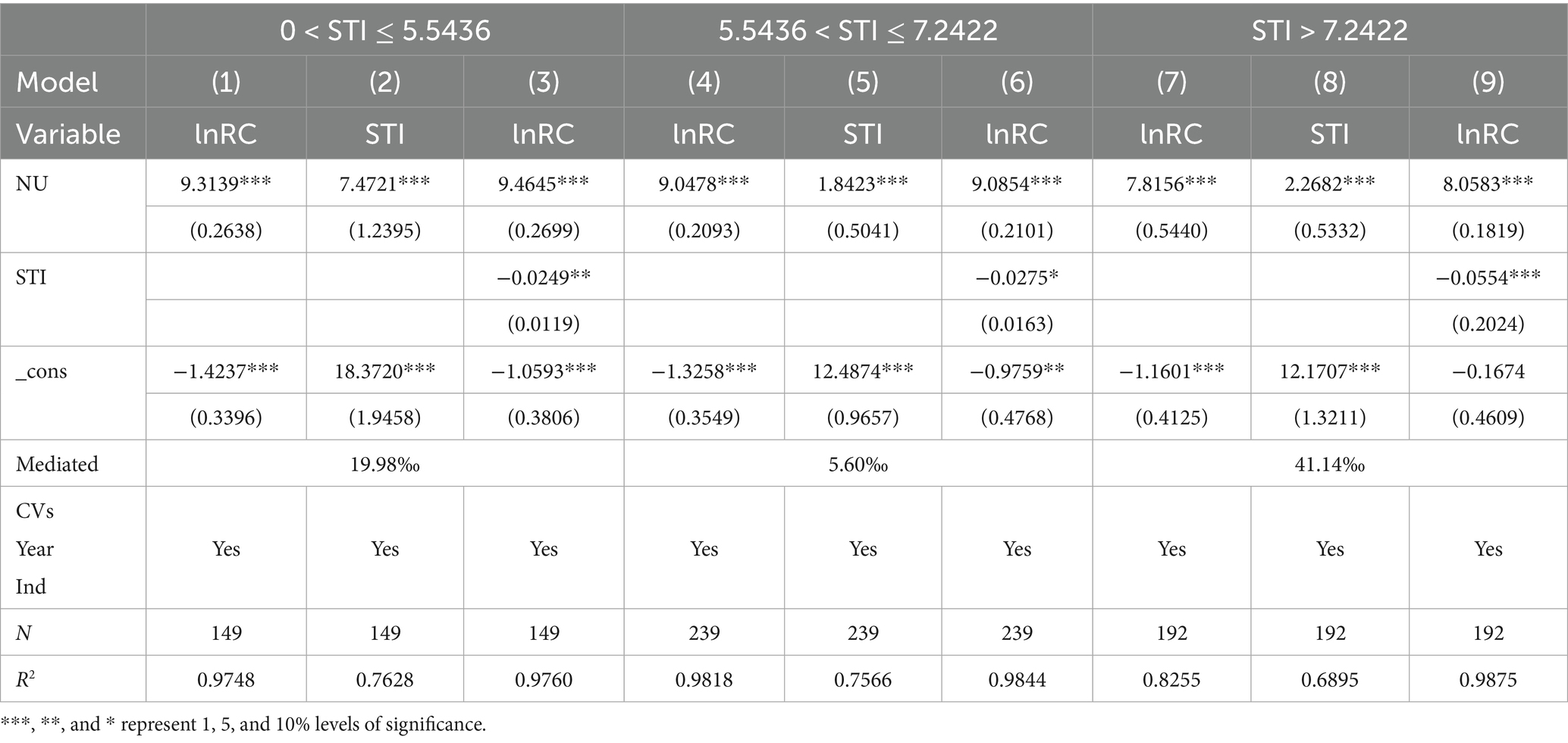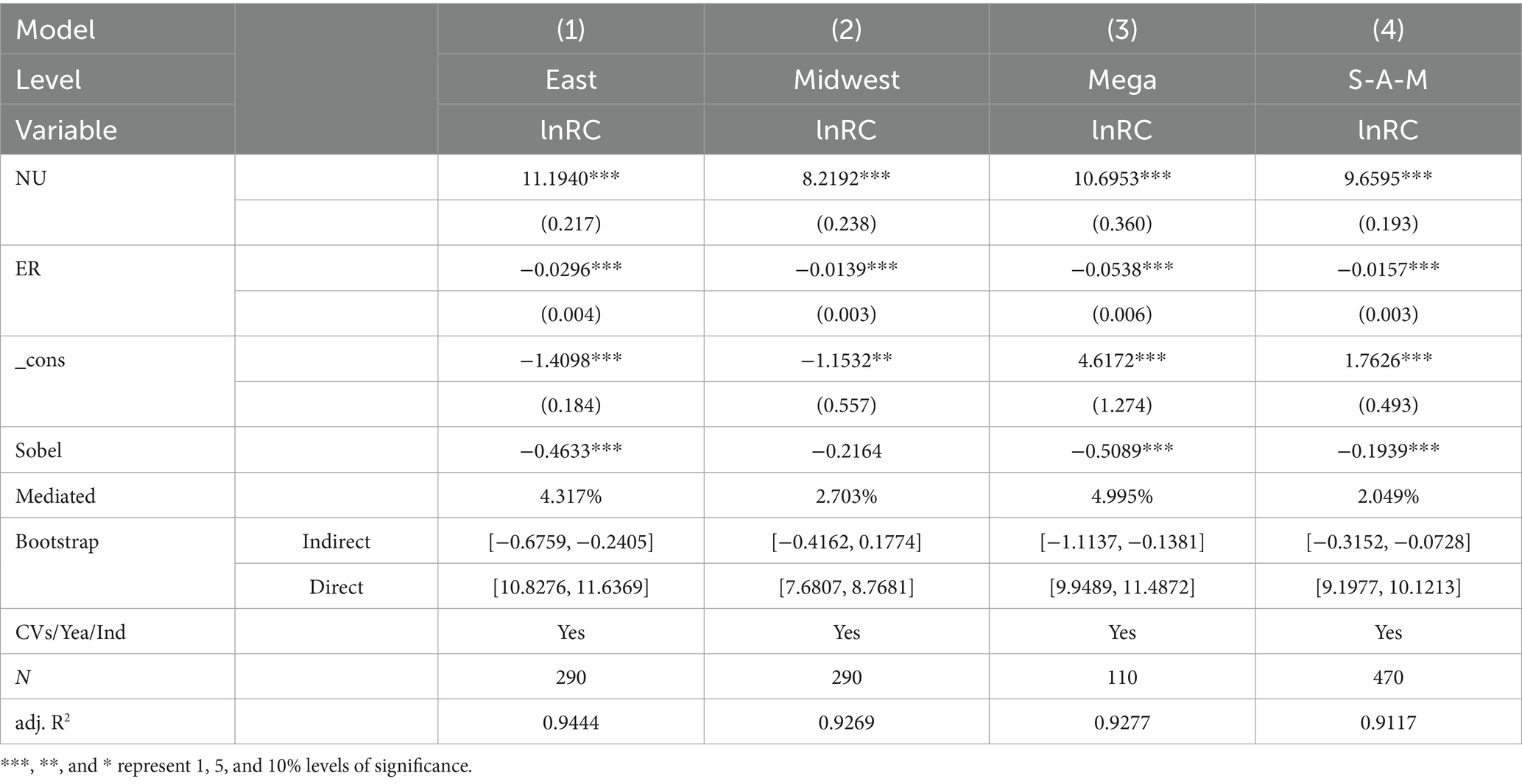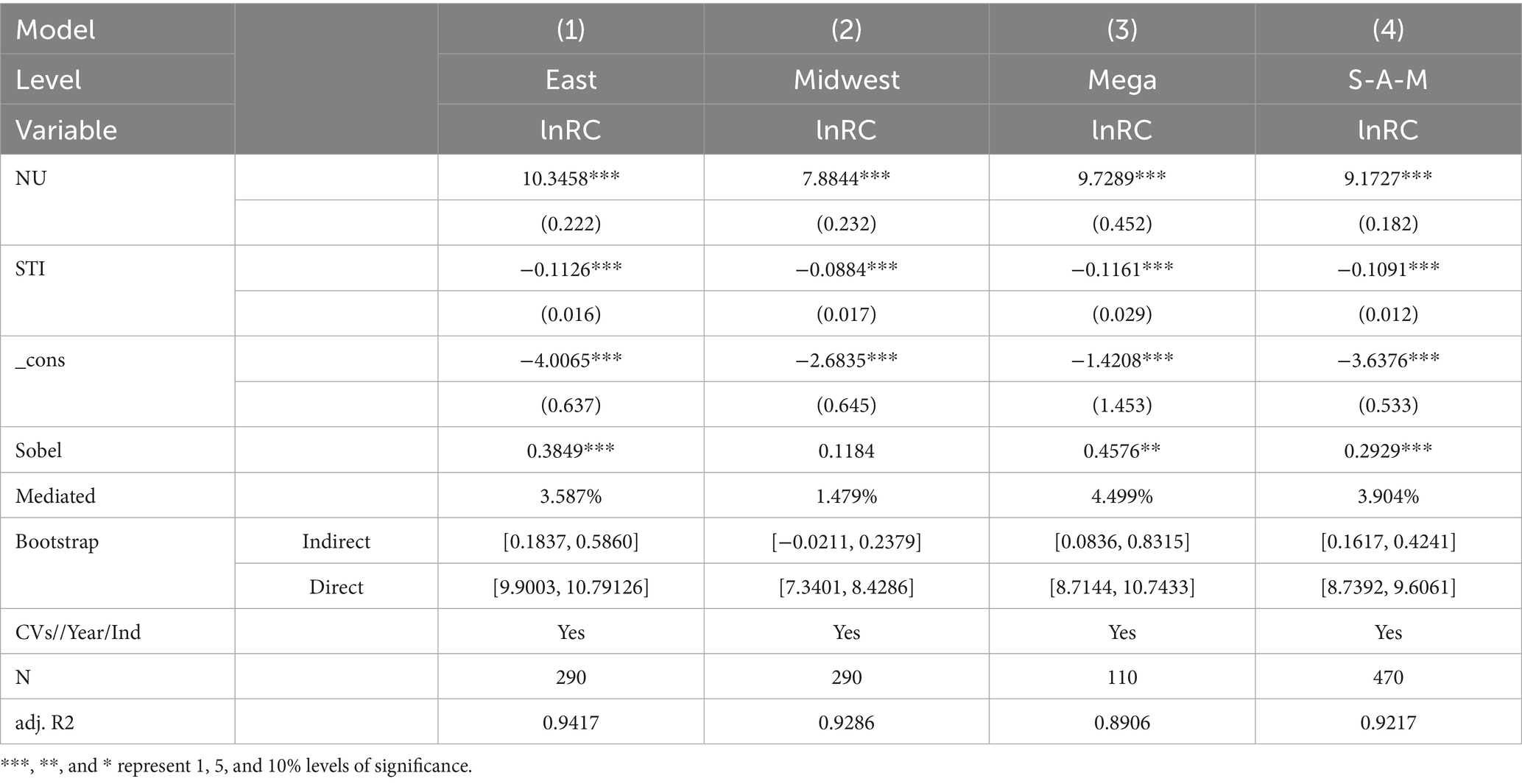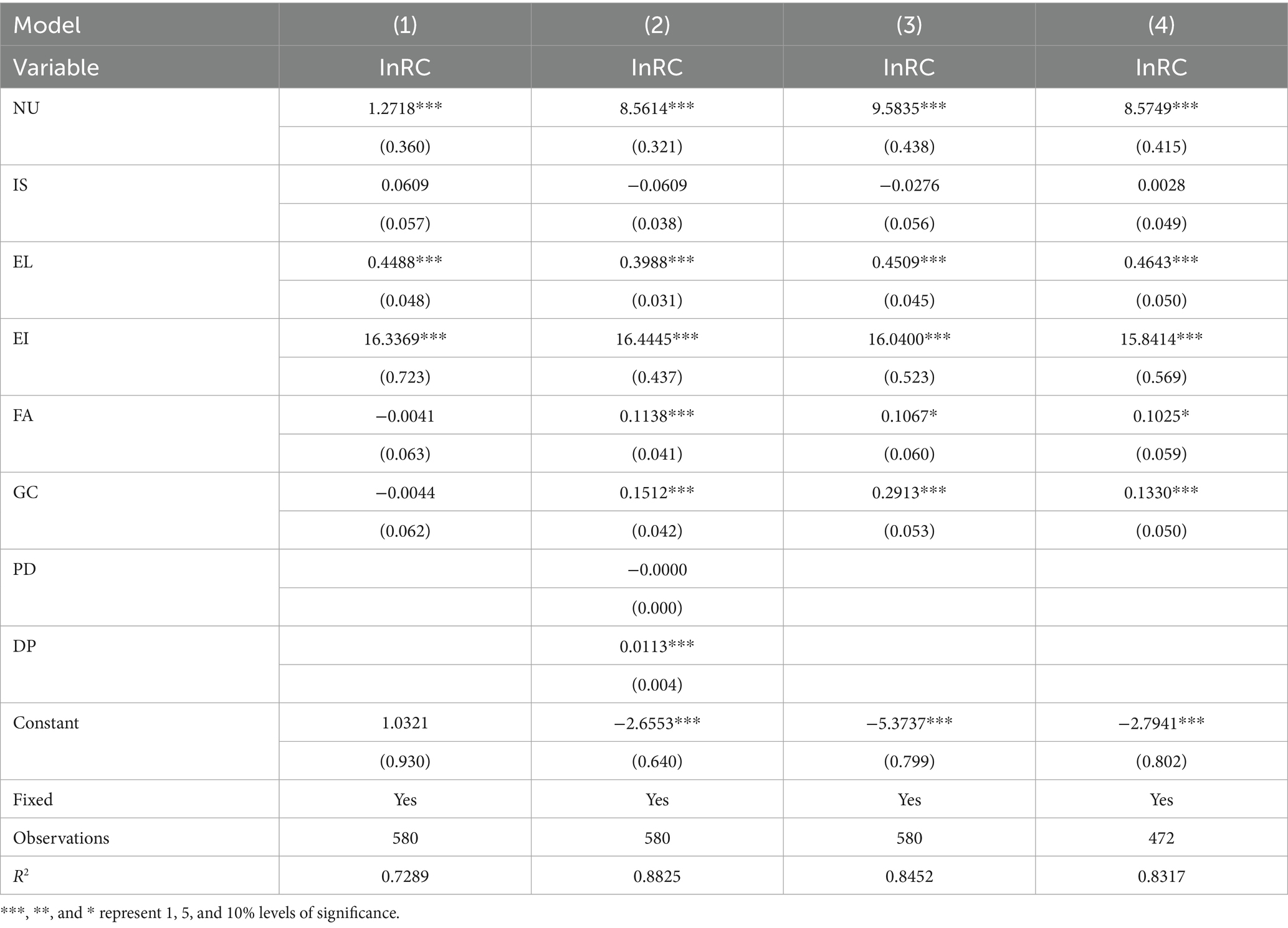- College of Business Administration, Liaoning Technical University, Huludao, China
Introduction: In the context of China’s new urbanization strategy and its “dual-carbon” goals, understanding the impact of urban transformation on carbon emissions in the residential sector is crucial. This study explores the influence mechanism of new urbanization on carbon emissions from residential buildings using panel data from 58 pilot cities between 2012 and 2021.
Methods: A comprehensive analytical framework incorporating fixed-effects, mediation, and threshold models is employed to examine the direct, mediating, and nonlinear effects of new urbanization.
Results: The empirical findings indicate that: (1) new urbanization has a significant positive impact on residential building carbon emissions; (2) environmental regulation and scientific and technological innovation (STI) serve as mediators, each exhibiting emission-reducing effects within this relationship; (3) both environmental regulation and STI demonstrate double-threshold effects, with the regulatory impact diminishing at higher intensities, while the mediating effect of STI follows a nonlinear U-shaped trend; and (4) the mediating roles of environmental regulation and STI are subject to substantial regional and urban-size heterogeneity, being more effective in eastern regions and megacities.
Discussion: These results offer new empirical insights into the carbon implications of urban development and provide policy guidance for differentiated, region-specific, and innovation-driven carbon reduction strategies in the residential sector.
1 Introduction
Environmental challenges driven by climate change have attracted increasing global attention. According to the Intergovernmental Panel on Climate Change (IPCC) Sixth Assessment Report, anthropogenic activities have contributed to a rise in global temperatures of approximately 0.8–1.2 °C since pre-industrial times. If current warming trends persist, global temperatures are projected to increase by 1.5 °C between 2030 and 2052 (1). To mitigate this trajectory, achieving near-zero carbon emissions in the energy sector by 2050 has become imperative. In response, China announced its commitment in September 2020 to peak carbon emissions by 2030 and achieve carbon neutrality by 2060 (2). Simultaneously, a strategic framework for new urbanization was introduced, emphasizing people-centered development as a vital pathway toward ecological civilization (3).
However, rapid urban population growth has led to a surge in carbon emissions, which presents significant challenges to high-quality urban development, undermines energy conservation efforts, and complicates the attainment of dual-carbon objectives. Among China’s major carbon-emitting sectors—industry, construction, and transportation—over 90% of total energy consumption and emissions are concentrated. Notably, the construction sector alone accounts for approximately one-third of the country’s energy consumption, with residential buildings contributing around 40% of that total, making them a primary source of emissions (4, 5). Although urbanization and increasing population density have driven the expansion of the construction industry, they have also intensified energy use and carbon dioxide emissions. In this context, the new urbanization paradigm emphasizes ecological progress, aiming to improve residents’ quality of life while reducing emissions from residential buildings. This underscores the complex and intertwined relationship between urbanization and carbon emissions.
Understanding this relationship has become a focal point of academic inquiry. Existing literature identifies three primary perspectives. First, some studies report no significant correlation between urbanization and carbon emissions (6, 7). Second, other studies suggest a linear relationship, though the direction remains contested. While some scholars argue that urbanization exacerbates emissions based on national panel data (8, 9), others find evidence of a mitigating effect, as shown by Huo et al. (10) and Wang et al. (11) using national and provincial datasets. The third school of thought proposes a nonlinear relationship. For example, studies have identified inverted “U” (12, 13) and “N” shaped curves across various regions of China (14). Multidimensional approaches, such as those by Feng et al. (15) and Hu et al. (16), emphasize that ecological, economic, and social factors may collectively mediate the influence of urbanization on emissions. In addition, sector-specific investigations provide further insights. Zheng et al. (17) demonstrate an inverted “U” relationship between urbanization and emissions in the digital economy, while Wang et al. (18) highlight spatial spillover effects from tourism. Lin et al. (19) examine emissions trends in the construction sector at the provincial level.
Despite these contributions, important gaps remain. Many studies adopt single-dimensional frameworks, lacking a comprehensive analysis of the multifaceted interactions between urbanization and carbon emissions. Moreover, much of the existing literature relies on provincial or national data, often overlooking city-level heterogeneity and spatial dynamics. Sector-specific impacts, particularly within the construction domain, are also underexplored, despite their significance to overall emissions.
To overcome the dual limitations prevalent in existing research - namely, the constrained single-dimensional analytical frameworks and the inadequate consideration of urban heterogeneity characteristics and spatial–temporal dynamics (20), the present study investigates 58 municipal pilot cities from 2012 to 2021. To more accurately quantify the level of new urbanization, this study first constructs a comprehensive evaluation system encompassing five key dimensions: population, economy, society, space, and ecology. To this end, the entropy weight method is employed to objectively weight indicators across these dimensions. Meanwhile, utilizing provincial carbon emission data and nighttime light data, city-level residential building carbon emissions are estimated through an inverse calculation approach. Furthermore, by establishing fixed-effects and mediation models, the study systematically analyzes the intrinsic mechanisms through which new urbanization influences residential building carbon emissions, thereby providing new empirical evidence for formulating differentiated low-carbon policies.
2 Theoretical analysis methods and research hypothesis
2.1 Influence mechanism
New urbanization represents a comprehensive and integrated development strategy that encompasses demographic, economic, social, spatial, and ecological dimensions. It aims to foster coordinated, efficient, low-carbon, and people-centered urban growth (3). From a theoretical standpoint, the impact of new urbanization on carbon emissions from residential buildings can be analyzed through three primary pathways: (1) a direct effect, (2) an indirect effect through mediating variables, and (3) a nonlinear effect characterized by threshold phenomena. The subsections below elaborate on these mechanisms and present the corresponding research hypotheses.
2.2 Direct effect
New urbanization influences carbon emissions from residential buildings through five primary mechanisms: (1) Population growth in urban areas intensifies the demand for household appliances, lighting, cooking equipment, and heating and cooling systems, leading to elevated carbon emissions. Concurrently, rising income levels, improved living standards, an increasing number of households, and shrinking household sizes all contribute to greater per capita energy consumption (21). (2) The growth in per capita GDP has resulted in higher wages and disposable incomes, driving up household energy consumption and associated carbon emissions. (3) Enhanced public services and social security systems attract more people to urban areas. For instance, broader pension coverage incentivizes rural-to-urban migration, thereby increasing residential energy demand and carbon output (22). (4) Urban Spatial Expansion: The influx of urban populations necessitates the development of expanded infrastructure—such as wider roads, new public buildings, and high-density residential complexes—which increases energy use both during and after construction (23). (5) Although ecological development is a core tenet of new urbanization, and greening efforts (e.g., increasing urban vegetation) can help sequester carbon and mitigate the urban heat island effect, these benefits are typically long-term (3). In contrast, the short-term impact of increased infrastructure investment may result in sustained energy demand and higher emissions (24). Consequently, hypothesis 1 suggests that new urbanization exerts a direct and positive effect on carbon emissions from residential buildings due to increased energy consumption associated with demographic, economic, and spatial development.
2.3 Indirect effect
New urbanization also exerts indirect effects on residential building carbon emissions through the promotion of environmental regulation and scientific and technological innovation (STI).
The advancement of new urbanization has significantly strengthened environmental regulatory frameworks, which serve as crucial instruments for reducing carbon intensity in the residential sector (25). Traditional urbanization processes often generated substantial environmental degradation, prompting the implementation of more stringent regulatory mechanisms in the new urbanization era. These include: pollution taxes and emissions trading systems, government subsidies for environmental protection, standardization of carbon emission metrics, incentives for energy-efficient appliances and green products. Such policy tools stimulate both producers and consumers to adopt sustainable practices, improve energy efficiency, and reduce household carbon emissions (26). Based on the above analysis hypothesis 2 is proposed: the new urbanization indirectly reduces residential building carbon emissions by enhancing environmental regulation, which acts as a mediating variable in this relationship.
STI is a key driver of social advancement and plays a vital role in achieving high-quality urban development (27). New urbanization emphasizes human capital development, technological progress, and the transition from primary and secondary industries toward tertiary sectors. This transition facilitates STI through: increased investment in research and development, adoption of low-carbon technologies and energy-efficient systems, and industrial structure optimization and cleaner energy integration. These technological innovations contribute to lowering residential energy demand and emissions through improved efficiency, smart building designs, and cleaner energy usage (28–30). Hypothesis 3: New urbanization indirectly reduces residential building carbon emissions by promoting scientific and technological innovation, which functions as a mediating variable in this process.
2.4 Threshold effect
The above analysis reveals that while new urbanization directly increases carbon emissions, environmental regulation and STI can mitigate this effect. However, the strength of these mediating effects may not be constant across all levels of development. This raises two key research questions (12–14): (1) Does the nonlinear relationship between new urbanization and carbon emissions—well-documented in aggregate analyses—also manifest in the residential building sector? (2) Is there an optimal threshold of environmental regulation or STI intensity beyond which their mediating effects are maximized? Understanding these threshold effects is critical for formulating effective policies, as it allows for the identification of inflection points where regulatory or technological investments yield the highest carbon mitigation benefits.
Combining the above analyses, the transmission mechanism by which new urbanization affects carbon emissions from residential buildings is illustrated in Figure 1. Based on this insight, Hypothesis 4 is proposed: The impact of new urbanization on carbon emissions from residential buildings exhibits a nonlinear relationship, with environmental regulation and scientific and technological innovation acting as threshold variables, each possessing distinct optimal levels of effectiveness.
3 Research design
3.1 Research methodology and model setting
3.1.1 Indicator measurement methodology
To accurately measure each sub-dimension index of new urbanization, this paper employs the entropy weight method. This method is chosen due to its high accuracy, broad applicability, strong objectivity, and superior ability to reflect changes in weights over time. The specific steps for applying the entropy weight method are based on the findings of Shang et al. (31).
3.1.2 Carbon emission measurement methodology for residential buildings
As one of the most widely used methods for evaluating carbon emissions from energy consumption, the Emission Factor Method is recommended by the IPCC in its Guidelines for National Greenhouse Gas Inventories for calculating carbon emissions. This method involves multiplying the consumption of each carbon source by its corresponding carbon emission factor and then summing these values to estimate the total emissions for a region. The principle behind this approach is encapsulated in the following Equation 1:
Where refers to the total carbon emissions from residential buildings in year t, refers to the consumption of energy i in year t, while corresponds to the carbon emission factor for energy i and n represents the type of energy.
3.1.3 Econometric modeling
Through the above analysis, considering that there are many factors affecting carbon emissions from residential buildings, it is challenging to include all their influencing factors in the regression model, and the endogeneity issues arising from the omitted variables can be effectively dealt with in the fixed-effects model, so the baseline regression model of this study is constructed as follows in Equation 2:
where is the carbon emissions from residential buildings in year t, is the level of new urbanization development in city i in year t, is a series of control variables, denotes the intercept term, denotes the estimated parameters of the core explanatory variables, represents the city fixed effects, represents the year fixed effects, and is the random error term.
In order to test the transmission mechanism of new urbanization on residential carbon emissions, i.e., whether environmental regulation and scientific and technological progress affect the relationship between the two, and to test whether there is a mediating effect between the two. Based on Hayes’s study (32) using the Bootstrap method with higher statistical validity, the model is constructed as follows:
Where is the mediator variable Equation 3 is the regression model of on the mediator variable and Equation 4 is the regression model of and the mediator variable on . The presence of the mediating effect was determined based on whether the 95% confidence interval contained zero.
In order to test the nonlinear effect of the impact of new urbanization on carbon emissions from residential buildings and the stage effect of the mediating variables, the threshold effect model proposed by Hansen is used for further analysis. And drawing on Lian’s (33) treatment, the threshold variables are double-tested. The following model is established:
where denotes the threshold variable, denotes the threshold value, is the indicator function, and the rest is the same as the above equation.
3.2 Variable selection
3.2.1 Explanatory variables
This paper selects the level of new urbanization (NU) as the explanatory variable. New urbanization goes beyond mere population growth; it represents a multifaceted phenomenon that must be assessed from various perspectives. To evaluate the level of new urbanization effectively, it is essential to integrate the people-centered urban development strategy with contemporary development concepts (16), ensuring a true reflection of the quality of new urbanization. Informed by the National New Urbanization Plan (2014–2020), the National New Urbanization Plan (2021–2035), and previous scholarly methods (34, 35), the evaluation system categorizes new urbanization into five sub-dimensions: demographic, economic, social, spatial, and ecological. Initially, considered 50 indicators for evaluation, but some were excluded due to insufficient relevance or suitability at the city level. After Using Ge ‘s approach (36), covariance and the coefficient of variation were applied to refine the indicators, resulting in the retention of eighteen. Detailed results are presented in Table 1.
3.2.2 Dependent variables
This paper selects residential building carbon emissions (RC) as the explanatory variable. Due to the absence of comprehensive energy statistics at the municipal level, calculating municipal carbon emissions directly by using the emission factor method is not feasible. However, scholars have validated the reliability of estimating CO2 emissions through inverse extrapolation from nighttime lighting data (37, 38). Based on this approach, this study employs ArcGIS to extract the total value of nighttime lighting (SDN) in each province, then linearly fits this data to carbon emissions calculated by the emission factor method. Considering the accuracy issues in the process of model dimensionality reduction and inversion, this study adopts a linear model without an intercept term to describe the linear relationship between the total provincial nighttime light value (SDN) and the carbon emissions of residential buildings, with denoting the parameters to be estimated. Thus, the formula is obtained. The fitting results are illustrated in Figure 2.
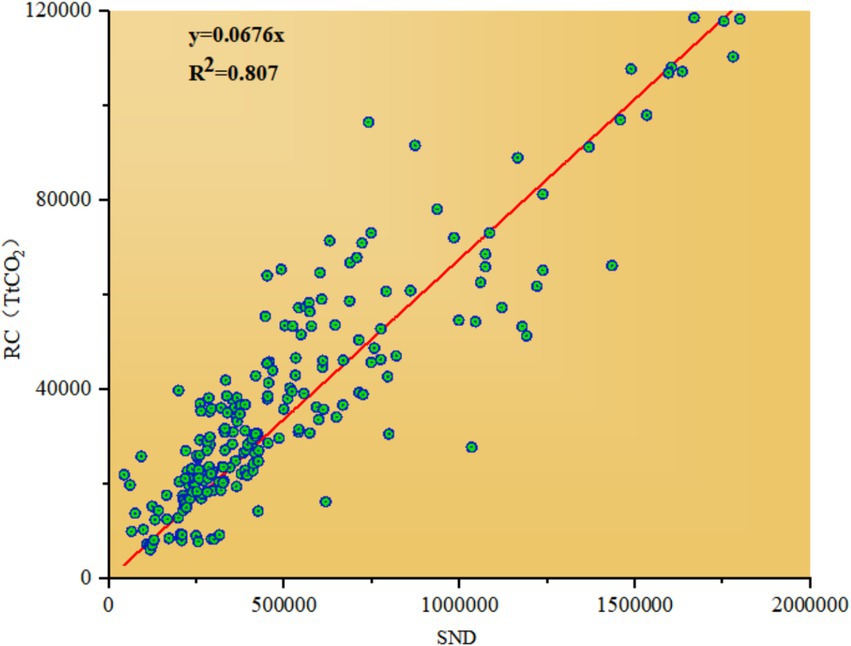
Figure 2. Fitting curve of provincial total nighttime light value and carbon emissions from residential buildings.
3.2.3 Mediating variables
Drawing on the research of previous scholars (30, 39), this paper selects environmental regulation (ER) as one of the mediating variables, and uses the investment in urban appearance and environmental sanitation to reflect the intensity of environmental regulation. The rationale is that environmental regulation involves three primary stakeholders: government, enterprises, and residents. Investment in amenities and sanitation signals the high priority governments place on such regulations, with greater investment typically indicating more stringent regulatory policies and measures. This encourages enterprises to adopt green technologies to minimize pollution emissions. Simultaneously, enhanced amenities improve residents’ quality of life and bolster their environmental awareness, fostering broader policy support and cooperation.
Another crucial variable, STI (40, 41), is measured by the number of granted invention patents. Invention patents are a vital indicator of technological innovation, manifesting originality and technological breakthroughs. They can effectively reflect the level of STI in a region or field, providing a quantifiable basis for relevant research and analysis. A high number of granted patents indicates robust R&D activities, effective translation of research into practical applications, and a strong emphasis on intellectual property within a city. This metric not only reflects the city’s innovative vitality and technological advancement but also highlights solid industrial support and a conducive innovation environment.
3.2.4 Control variables
To address potential omissions that might affect the equity of urban residential carbon emissions, several control variables are included to provide a comprehensive analysis. The industrial structure (IS) (39) optimizes the industrial environment, limits the expansion of high-polluting industries, and facilitates industrial upgrades that directly reduce carbon emissions. Regions with higher economic levels (EL) (30) typically experience accelerated urbanization, leading to increased building energy consumption and carbon emissions. Economic activities with high energy intensity (EI) (40) require more energy to sustain, generally resulting in heightened carbon emissions. An increase in floor area (FA) (41) raises demand for heating, cooling, electricity, and materials, thus elevating energy use and carbon emissions. Government capacity (GC) (42) influences policy development, the promotion of energy efficiency standards, and the application of green technologies, all aimed at minimizing building-related carbon emissions. These factors are measured as follows: the proportion of secondary and tertiary industries (IS); the logarithm of fixed asset investment (EL); energy consumption per unit of GDP (EI); the land area used for urban residential buildings in the current year (FA); and the sum of public finance revenue and expenditure (GC).
3.3 Data sources and descriptive statistics
The data for indicators and control variables used to evaluate the level of new urbanization were sourced from the 2012–2022 editions of the China Urban Statistical Yearbook, China Urban and Rural Construction Statistical Yearbook, and the Statistical Bulletin of National Economic and Social Development of Cities, as well as the Statistical Yearbook of Cities. Information relevant to calculating carbon emissions from residential buildings was extracted from the 2012–2022 editions of the China Energy Statistical Yearbook, the China Urban and Rural Construction Statistical Yearbook, and the 2006 Guidelines for National Greenhouse Gas Inventories. Descriptive statistics of the collected data are presented in Table 2.
4 Empirical results and analysis
4.1 Analysis of new urbanization levels in pilot cities
The entropy weight method was employed to evaluate the level of new urbanization across multiple dimensions, and the results are visually presented in Figure 3. The figure illustrates a steady upward trend in urbanization development scores, reflecting comprehensive progress across all dimensions. Among these, population urbanization achieved the highest score, indicating a pronounced concentration of population in urban areas, followed by ecological urbanization. Although social and spatial urbanization exhibited relatively lower scores, both dimensions demonstrated gradual improvement over time.
In terms of growth rates, the overall level of new urbanization increased by 25.82% during the study period. Notably, economic urbanization experienced the most substantial growth, rising by 138.79%, which underscores the pivotal role of economic restructuring as the main driver of new urbanization. Social urbanization followed, while demographic and ecological urbanization showed comparable growth trajectories. In contrast, spatial urbanization advanced at a slower pace, with a growth rate of only 11.89%. When considering average annual growth, economic urbanization stood out with a rate of 10.09%, highlighting its strong momentum and underlying economic dynamism.
Furthermore, substantial regional disparities were observed among the pilot cities in terms of their urbanization development levels. The Eastern region consistently outperformed both the Central and Western regions, with the Central region demonstrating moderate but steady progress. At the city level, eastern cities such as Nanjing, Suzhou, and Ningbo ranked among the highest in terms of new urbanization, whereas western cities like Luzhou, Qujing, and Anshun remained at the lower end of the spectrum. This regional heterogeneity can be attributed to differences in industrialization, economic strength, infrastructure quality, and technological capacity. The Eastern region benefits from advanced industrial bases, strong economic performance, and superior infrastructure—all of which are critical to driving new urbanization. In contrast, the Western region faces structural challenges, including complex topography and underdeveloped transportation networks, which constrain economic development and limit urban expansion.
Understanding these regional disparities is essential for identifying the fundamental causes of uneven development and for formulating targeted policy interventions. Such efforts can promote more balanced, inclusive, and coordinated urbanization across different regions of China.
4.2 Analysis of carbon emissions from residential buildings in pilot cities
Carbon emissions from residential buildings at the city level were estimated using nighttime light data in conjunction with provincial residential carbon emission figures. Based on this estimation, the temporal and spatial trends of carbon emissions in the pilot cities were analyzed, as illustrated in Figure 4. Overall, the period from 2012 to 2021 witnessed a continuous rise in residential building carbon emissions across these cities. Notably, the rate of increase slowed during the latter half of the study period (2016–2021) compared to the earlier years (2012–2015), suggesting that new urbanization initiatives have contributed to curbing the acceleration of emissions growth.
A spatial analysis of the data reveals a clear regional pattern: carbon emissions from residential buildings generally increase from west to east, with a pronounced concentration in the northeastern region. This spatial distribution underscores significant regional heterogeneity. In western cities, lower carbon emissions are primarily due to lower population densities and the relatively delayed onset of urbanization, both of which contribute to reduced building energy consumption. In contrast, eastern cities are characterized by dense commercial and residential development, leading to greater reliance on energy-intensive systems such as air conditioning, lighting, and household appliances, thereby resulting in higher carbon emissions.
Recognizing and understanding these regional disparities is essential for formulating targeted strategies to mitigate carbon emissions. Tailored approaches that account for the distinct urbanization patterns and energy use behaviors in different regions will be critical to achieving sustainable, low-carbon urban development.
4.3 Direct effect test analysis
To begin the empirical analysis, panel unit root tests were conducted for all variables in the dataset. The results indicate that all variables, or their first-order lag terms, are stationary, thereby satisfying the requirements for subsequent panel data analysis. Following this, both correlation coefficient and variance inflation factor (VIF) tests were performed to assess potential multicollinearity among the independent variables. As shown in Table 3, the absolute values of all pairwise correlation coefficients are below 0.8, and the VIF values for all variables are less than 10. These findings confirm the absence of multicollinearity, ensuring the reliability of the regression results.
Subsequently, both fixed-effects and random-effects models were applied to conduct benchmark regressions. The Hausman test was employed to determine the most appropriate model specification. The test results supported the fixed-effects model, indicating that it yields more consistent and efficient estimates.
To further account for both individual (city-level) and time (yearly) effects, regressions were performed using individual fixed-effects and two-way fixed-effects models. Columns (1) and (2) in Table 4 present the baseline regression results for new urbanization (NU) on residential building carbon emissions (lnRC). In both models, NU is positively and significantly associated with carbon emissions at the 1% significance level, confirming Hypothesis 1: that new urbanization contributes to an increase in residential building carbon emissions.
Columns (3) and (4) extend the baseline analysis by incorporating control variables—industrial structure (IS), economic level (EL), energy intensity (EI), floor area (FA), and government capacity (GC). The positive and highly significant coefficient for NU remains robust, reaffirming the initial finding.
Among the control variables, IS, EL, EI, and FA are all positively and significantly associated with carbon emissions at the 1% level. Notably, EI exhibits the largest effect size, underscoring the critical role of energy efficiency in emission reduction efforts. The coefficient for GC is positive but statistically insignificant in the two-way fixed-effects model.
The significant positive coefficient for IS suggests that a higher proportion of secondary industry activity hinders efforts to reduce residential building emissions. The positive impact of EL reflects a dual mechanism: economically developed cities tend to prioritize growth over ecological sustainability in early urbanization phases, while their increased population density and commercial activity further elevate residential energy consumption. EI, as a measure of energy efficiency, indicates that higher energy intensity—implying lower efficiency—leads to greater energy use for basic activities such as heating and electricity, thereby increasing emissions. Similarly, FA contributes positively and significantly to emissions, as expanded building areas require more energy for lighting, heating, and cooling.
Comparing model fits, the two-way fixed-effects model (columns 2 and 4) achieves higher adjusted R2 values than the individual fixed-effects model, suggesting that controlling for both city and year effects provides better explanatory power. The random-effects model presented in column (5), while still significant, shows a lower R2 value than the two-way fixed-effects model, corroborating the Hausman test results and justifying the selection of the two-way fixed-effects model for subsequent analyses.
4.4 Analysis of the mediating effects test
The preceding analysis confirms that new urbanization significantly increases carbon emissions from residential buildings. To further examine the mechanisms underlying this relationship—specifically Hypotheses 2 and 3—Equation 3 is employed to test the mediating effects of environmental regulation and scientific and technological innovation (STI). The regression results are presented in Table 5.
Column (1) reports the baseline regression of new urbanization on residential carbon emissions, showing a significantly positive coefficient for new urbanization. Columns (2) and (4) examine the influence of new urbanization on environmental regulation and STI, respectively. Columns (3) and (5) then incorporate these mediating variables into the baseline regression to assess their impact on carbon emissions.
In Column (2), the coefficient for new urbanization is significantly positive at the 5% level, indicating that the development of new urbanization promotes the strengthening of environmental regulation. In Column (3), when environmental regulation is included as a mediating variable, its coefficient is significantly negative, while the coefficient for new urbanization remains significantly positive. This suggests that increased regulatory intensity contributes to lower residential carbon emissions, even as urbanization progresses. The opposite signs of the new urbanization coefficient in Column (2) and the environmental regulation coefficient in Column (3) imply a masking effect—environmental regulation partially offsets the positive effect of new urbanization on emissions. Specifically, this masking effect accounts for 0.11‰ of the total effect, confirming the partial mediating role of environmental regulation.
Similarly, Column (4) demonstrates a significantly positive association between new urbanization and STI at the 5% level, indicating that urbanization development fosters technological progress. In Column (5), where STI is introduced as a mediating variable, its coefficient is significantly negative at the 1% level, while new urbanization remains positively associated with carbon emissions. The opposing signs between the coefficient of new urbanization in Column (4) and the STI coefficient in Column (5) also indicate a masking effect, wherein STI mitigates the positive influence of urbanization on emissions. This masking effect accounts for 4.86‰ of the total effect, suggesting that technological innovation plays a more substantial mediating role than environmental regulation.
Taken together, these results validate Hypotheses 2 and 3, confirming that both environmental regulation and STI function as mediators that reduce the impact of new urbanization on carbon emissions from residential buildings. Although new urbanization has a stronger influence on environmental regulation than on STI, the latter exerts a more pronounced mediating effect in curbing emissions. Therefore, enhancing STI capacity may offer a more effective strategy for mitigating urbanization-driven carbon emissions in the residential sector.
4.5 Threshold effect test analysis
4.5.1 Threshold effect test
Before constructing the panel threshold effects model, two essential tests were conducted to ensure the robustness and validity of the threshold estimations. The first is the threshold significance test, which evaluates whether the estimated parameter values differ significantly across subgroups delineated by potential threshold values. This test primarily utilizes the F-statistic and its associated p-value to determine statistical significance. The second is the threshold estimate accuracy test, which employs the Bootstrap method to assess the consistency and reliability of the threshold estimates. This method uses the likelihood ratio (LR) statistic to verify whether the identified thresholds align with the true values.
To examine Hypothesis 4, Equation 5 was applied, and the corresponding results are presented in Table 6. The findings reveal that the double-threshold effect of environmental regulation is statistically significant at the 1% level, confirming the presence of two thresholds. The F-statistic for the triple-threshold test, however, is not significant, indicating that the effect does not extend beyond two thresholds. Similarly, for STI, the single-threshold and double-threshold F-values are 11.07 and 10.62, respectively—both significant at the 5% level. This confirms the presence of a double-threshold effect for STI as well, while the triple-threshold result remains insignificant.
Further validation is provided in Table 7, which presents the estimated threshold values and their corresponding 95% confidence intervals. The identified thresholds for environmental regulation are 15.3112 and 20.0849, while those for STI are 5.5436 and 7.2422. These results are graphically supported by the likelihood ratio curves shown in Figures 5, 6, which affirm the stability and validity of the double thresholds through visual inspection of the LR statistics.
In summary, the analysis confirms the presence of a nonlinear relationship between new urbanization and carbon emissions from residential buildings. Both environmental regulation and STI demonstrate significant double-threshold effects, indicating that their mediating roles vary across different intensities. These threshold effects highlight the importance of optimal regulatory and technological development levels in mitigating the environmental impacts of urbanization.
4.5.2 Analysis of threshold regression results
To further test the strength and effective range of the mediating effect under different thresholds, adopt the mediated threshold effect model, drawing on the approaches of Guo et al. (43) and Qin et al. (44) for deeper analysis.
Table 8 presents the mediation test results for environmental regulation (ER) across three threshold ranges. Columns (1)–(3) show results when ER is below the first threshold (ER ≤ 15.3112); columns (4)–(6) represent the intermediate range (15.3112 < ER ≤ 20.0849); and columns (7)–(9) reflect the upper range (ER > 20.0849).
The results indicate that environmental regulation exhibits a significant mediating effect in both the lower and middle threshold intervals. Specifically, the mediating effect accounts for 70.88‰ of the total effect when ER is below the first threshold, and 38.39‰ when ER is between the first and second thresholds. However, when ER exceeds the second threshold, its mediating effect becomes statistically insignificant.
These findings confirm the presence of a double-threshold effect in environmental regulation, with thresholds identified at 15.3112 and 20.0849. In the first threshold range, new urbanization is positively and significantly associated with carbon emissions at the 1% level. It is also positively correlated with ER, while ER itself shows a significant negative effect on carbon emissions, thereby acting as a mediator. This suggests that, in the early phase of urban development, enhancing environmental regulation effectively suppresses the growth of residential building emissions.
In the middle threshold range, ER continues to mediate the impact of new urbanization, but its relative contribution decreases. This indicates diminishing marginal returns to the mediating role of ER as its intensity increases. Once ER surpasses the second threshold (ER > 20.0849), the correlation between ER and new urbanization becomes statistically insignificant, nullifying the mediating effect.
This pattern suggests that environmental regulation is most effective in the early to intermediate stages of urbanization. Initially, as regulatory frameworks strengthen, they play a vital role in controlling emissions. However, once regulatory efforts reach a certain saturation point, their marginal impact declines. This could be due to escalating economic and administrative costs associated with stricter regulations, such as higher compliance burdens, costlier pollution control measures, and stringent building codes. These factors may lead to noncompliance or regulatory evasion, thereby undermining the effectiveness of environmental regulation in mitigating carbon emissions.
Table 9 displays the mediation test results for scientific and technological innovation (STI) across three threshold intervals: columns (1)–(3) for STI ≤ 5.5436, columns (4)–(6) for 5.5436 < STI ≤ 7.2422, and columns (7)–(9) for STI > 7.2422.
Across all three intervals, STI consistently serves as a significant mediating factor in the relationship between new urbanization and residential carbon emissions. The masking effects, representing the proportion of the total effect mediated by STI, are 19.98‰, 5.60‰, and 41.14‰ respectively—indicating an initial decline followed by a notable increase in the mediating impact.
According to the double-threshold test results, STI exhibits significant thresholds at 5.5436 and 7.2422. Throughout all three stages, new urbanization is positively associated with both carbon emissions and STI at the 1% level, confirming that urbanization fosters technological advancement. At the same time, STI exerts a negative effect on carbon emissions, statistically significant at the 10% level or higher, and its inhibitory strength increases progressively across the threshold intervals.
This consistent masking effect suggests that STI plays a persistent role in attenuating the emissions impact of new urbanization. In the initial stage, STI helps reduce emissions by promoting energy-efficient building designs and technologies. However, as urbanization intensifies and population density rises, the surge in housing demand leads to escalating energy consumption, potentially outpacing the benefits of current STI capabilities. Additionally, certain advanced emission-reducing technologies may face financial, structural, or technological barriers that limit their large-scale implementation.
Nevertheless, in the third threshold range (STI > 7.2422), the mediating effect of STI strengthens significantly, accounting for 41.14‰ of the total effect. This indicates that as STI overcomes early-stage limitations—through technological breakthroughs, cost reductions, or broader policy support—it regains and enhances its capacity to mitigate carbon emissions from residential buildings.
4.6 Heterogeneity analysis
To explore the potential heterogeneous effects of environmental regulation and scientific and technological innovation (STI) on carbon emissions from residential buildings, the 58 pilot cities were further categorized based on regional and size-based criteria established by the National Bureau of Statistics of China. Two main classification rules were applied:
1. Geographic heterogeneity, which distinguishes between eastern and midwestern cities, and.
2. City size heterogeneity, which separates megacities (population ≥ 5 million) from small and medium-sized cities (S-A-M) (population < 5 million).
As shown in Table 10, the influence of environmental regulation on carbon emissions exhibits clear regional and size-based differences. In the eastern region, the coefficient for ER is −0.0296 and statistically significant, indicating a strong and effective inhibitory effect on emissions—likely due to better policy implementation, infrastructure, and regulatory enforcement.
In contrast, midwestern cities also show a significant negative ER coefficient (−0.0139), though smaller in magnitude. This suggests that while environmental regulation is functioning, its impact is more limited, possibly due to less developed infrastructure and weaker enforcement mechanisms.
Among city size categories, megacities demonstrate the strongest regulatory effect (ER coefficient = −0.0538), supported by concentrated resources, advanced technological infrastructure, and heightened environmental awareness. In comparison, S-A-M cities show a weaker but still significant effect (ER coefficient = −0.0157), potentially reflecting constraints in funding, administrative capacity, or policy implementation.
The Sobel test further supports these findings: the mediation effect of ER is most pronounced in eastern cities (4.317%) and megacities (4.995%), indicating that ER serves as a more effective mediating mechanism in these contexts. The bootstrap confidence intervals for indirect effects also confirm the statistical robustness of these mediating roles, especially in the eastern and megacity subsamples.
Similar patterns of heterogeneity are observed for STI, as presented in Table 11. In eastern cities, STI exhibits a strong dampening effect on carbon emissions (coefficient = −0.1126), suggesting the successful implementation of policies and technological measures. In midwestern cities, while the effect is somewhat smaller (coefficient = −0.0884), it remains statistically significant, indicating that STI still contributes to emissions mitigation despite regional development disparities.
Among city size categories, megacities display the most substantial reduction effect (STI coefficient = −0.1161), highlighting their greater capacity for deploying advanced technologies and strict emissions strategies. Meanwhile, S-A-M cities also demonstrate a significant STI effect (coefficient = −0.1091), suggesting that well-targeted policy support can yield meaningful carbon reductions even under more constrained conditions.
The Sobel test and associated mediation effect analyses reinforce the above observations. STI shows the highest mediation effect in megacities (4.499%), followed by eastern cities (3.587%) and S-A-M cities (3.904%). Although the midwestern region exhibits a smaller mediation proportion (1.479%), its positive direction suggests untapped potential. The bootstrap confidence intervals for indirect effects do not include zero for the eastern, megacity, and S-A-M categories, confirming statistical significance and robust mediation effects in these subgroups.
Importantly, all models report adjusted R2 values above 0.89, indicating excellent model fit across regional and city size categories.
These results underscore the heterogeneous effectiveness of environmental regulation and STI in reducing residential building carbon emissions. Both mediating mechanisms perform more effectively in eastern regions and megacities, likely due to better infrastructure, more advanced technological bases, and stronger governance capacity. In contrast, midwestern and smaller cities may require additional policy support, capacity building, and infrastructure investment to maximize the benefits of environmental and technological interventions. Accordingly, future emission reduction strategies should be tailored to local conditions, leveraging regional strengths while addressing area-specific constraints to advance balanced and sustainable urban development.
4.7 Robustness tests
To ensure the reliability of the empirical findings, a series of robustness tests were conducted, including variable substitution, the addition of control variables, exclusion of outliers, and restriction of the sample period. The results are summarized in Table 12.
In Column (1), the core explanatory variable—new urbanization (NU)—has a coefficient of 1.2718, which is lower than that observed in the baseline regression but remains statistically significant at the 1% level. This confirms that the effect of NU on residential carbon emissions is stable even when key variables are substituted.
In Column (2), two additional control variables—population density (PD) and demographic profile (DP)—are introduced. The coefficient for NU remains significantly positive (8.5614), reinforcing the robustness of its effect. Notably, economic level (EL) continues to be highly significant, suggesting its consistent role in influencing carbon emissions across model specifications.
Column (3) presents the results after removing outliers. The NU coefficient increases to 9.5835, indicating that the observed effect is not driven by extreme values in the dataset. This further validates the consistency of the NU-emissions relationship.
Finally, in Column (4), the sample period is shortened, reducing the number of observations to 472. Even under this constraint, the NU coefficient remains significant (8.5749), confirming the temporal stability of the effect.
Across all models, the coefficients of other control variables—particularly EL, energy intensity (EI), and government capacity (GC)—are generally stable and statistically significant. The adjusted R2 values remain relatively high (ranging from 0.7289 to 0.8825), indicating good model fit and explanatory power.
These robustness tests collectively confirm the reliability and consistency of the core finding: new urbanization significantly contributes to increased carbon emissions from residential buildings, and this relationship holds under various model specifications and sample treatments.
5 Conclusions and recommendations
5.1 Conclusion
This study employs multiple econometric models to elucidate the complex mechanisms through which new urbanization affects carbon emissions from residential buildings, with three key contributions: (1) Identifying the diminishing marginal effect of ER and the U-shaped moderating pattern of STI, providing quantitative benchmarks for determining policy intervention thresholds; (2) Proposing a differentiated policy framework of “innovation-driven development in eastern regions versus regulation-prioritized approaches in central-western regions” based on geospatial heterogeneity; (3) Establishing a relatively comprehensive urbanization evaluation model that verifies STI’s critical role in breaking the “carbon lock-in” effect. Future research could incorporate emerging variables such as digital technology applications and green finance to extend the analytical dimensions.
5.2 Recommendations
Drawing on empirical evidence, this study formulates a coherent policy framework for low-carbon urban development in China’s new urbanization context. The integrated approach addresses three critical dimensions: First, urban planning must systematically incorporate energy-saving measures through rigorous building efficiency standards, low-carbon design promotion, and equitable resource allocation across development zones to counter residential emissions growth. Second, region-specific strategies should be implemented, with eastern cities focusing on regulatory optimization and industry-academia-research partnerships for clean technology deployment, while central/western cities prioritize infrastructure upgrades and enhanced research and development investments. Third, a city-tiered implementation system should be established, where megacities lead in adopting advanced environmental policies and green technology integration, complemented by small-medium cities implementing cost-effective solutions through periodic evaluation mechanisms and incremental innovation capacity building via regional technology hubs. This multi-scalar policy architecture ensures systematic emissions reduction while accommodating regional disparities and urban heterogeneity.
Data availability statement
The raw data supporting the conclusions of this article will be made available by the authors, without undue reservation.
Author contributions
YW: Conceptualization, Methodology, Writing – original draft. ZT: Writing – original draft, Writing – review & editing. YZ: Writing – original draft, Project administration.
Funding
The author(s) declare that financial support was received for the research and/or publication of this article. The work was supported by (1) 2025 Liaoning Economic and Social Development Research Project: Research on the Mechanism and Path of Low-Carbon Transformation of the Construction Industry Driven by Construction Industrialization (No. 2025lslybwzzkt-154); (2) 2023 General Project of the University’s Social Science Department: Research on the Influencing Factors of Carbon Emissions from Residential Buildings in Towns and Cities in Liaoning and the Control Mechanisms of Them (No. 23-A041).
Acknowledgments
Thanks to all the colleagues who contributed to this article.
Conflict of interest
The authors declare that the research was conducted in the absence of any commercial or financial relationships that could be construed as a potential conflict of interest.
Generative AI statement
The authors declare that no Gen AI was used in the creation of this manuscript.
Any alternative text (alt text) provided alongside figures in this article has been generated by Frontiers with the support of artificial intelligence and reasonable efforts have been made to ensure accuracy, including review by the authors wherever possible. If you identify any issues, please contact us.
Publisher’s note
All claims expressed in this article are solely those of the authors and do not necessarily represent those of their affiliated organizations, or those of the publisher, the editors and the reviewers. Any product that may be evaluated in this article, or claim that may be made by its manufacturer, is not guaranteed or endorsed by the publisher.
Supplementary material
The Supplementary material for this article can be found online at: https://www.frontiersin.org/articles/10.3389/fpubh.2025.1628610/full#supplementary-material
References
1. Mukherji, A, Thorne, P, Cheung, W, Connors, S, Garschagen, M, Geden, O, et al. AR6 synthesis report: Climate change 2023 IPCC (2023). London.
2. Li, W, Elheddad, M, and Doytch, N. The impact of innovation on environmental quality: evidence for the non-linear relationship of patents and CO2 emissions in China. J Environ Manag. (2021) 292:112781. doi: 10.1016/j.jenvman.2021.112781
3. Deng, ZB, Zong, SW, Su, W, and Chen, Z. Study on the coupled and coordinated development of ecological civilization construction and new urbanization in the Yangtze River Economic Belt and its driving factors. Econ Geogr. (2019) 39:78–86.
4. Project Synthesis Report Preparation Group. Synthesis report on the study on China's long-term low-carbon development strategies and transition paths. China s Popul Resour Environ. (2020) 30:1–25.
5. China Association of Building Energy Efficiency, Institute of Urban and Rural Construction and Development, Chongqing University. China building energy consumption and carbon emission research report (2023). ConstructArchitect. (2024) 2:46–59.
6. Ji, SD, Wu, H, and Wang, Z. Trade openness, urbanization development and carbon dioxide emissions-an analysis of marginal co-integration tests based on Chinese urban panel data. Econ Problems. (2013) 12:31–5.
7. Rafiq, S, Salim, R, and Nielsen, I. Urbanization, openness, emissions, and energy intensity: a study of increasingly urbanized emerging economies. Energy Econ. (2016) 56:20–8. doi: 10.1016/j.eneco.2016.02.007
8. Musah, M, Kong, Y, Mensah, IA, Antwi, SK, and Donkor, M. The connection between urbanization and carbon emissions: a panel evidence from West Africa. Environ Dev Sustain. (2021) 23:11525–52. doi: 10.1007/s10668-020-01124-y
9. Salahuddin, M, Ali, MI, Vink, N, and Gow, J. The effects of urbanization and globalization on CO 2 emissions: evidence from the sub-Saharan Africa (SSA) countries. Environ Sci Pollut Res Int. (2019) 26:2699–709. doi: 10.1007/s11356-018-3790-4
10. Huo, T, Li, X, Cai, W, Zuo, J, Jia, F, and Wei, H. Exploring the impact of urbanization on urban building carbon emissions in China: evidence from a provincial panel data model. Sustain Cities Soc. (2020) 56:102068. doi: 10.1016/j.scs.2020.102068
11. Wang, W-Z, Liu, L-C, Liao, H, and Wei, Y-M. Impacts of urbanization on carbon emissions: an empirical analysis from OECD countries. Energy Policy. (2021) 151:112171. doi: 10.1016/j.enpol.2021.112171
12. Wang, Q, and Wang, L. The nonlinear effects of population aging, industrial structure, and urbanization on carbon emissions: a panel threshold regression analysis of 137 countries. J Clean Prod. (2021) 287:125381. doi: 10.1016/j.jclepro.2020.125381
13. Liu, S, Shen, J, Liu, G, Wu, Y, and Shi, K. Exploring the effect of urban spatial development pattern on carbon dioxide emissions in China: a socioeconomic density distribution approach based on remotely sensed nighttime light data. Comput Environ Urban Syst. (2022) 96:101847. doi: 10.1016/j.compenvurbsys.2022.101847
14. Yang, XJ, and Chen, H. The effect of urbanization on carbon dioxide emissions in China: an empirical analysis based on provincial panel data. J China Univ Geosci. (2013) 13:32–7.
15. Feng, Y, Liu, Y, and Yuan, H. The spatial threshold effect and its regional boundary of new-type urbanization on energy efficiency. Energy Policy. (2022) 164:112866. doi: 10.1016/j.enpol.2022.112866
16. Hu, C, Ma, X, Liu, Y, Ge, J, Zhang, X, and Li, Q. Mechanism and spatial spillover effect of new-type urbanization on urban CO2 emissions: evidence from 250 cities in China. Land. (2023) 12:1047. doi: 10.3390/land12051047
17. Zheng, R, Wu, G, Cheng, Y, Liu, H, Wang, Y, and Wang, X. How does digitalization drive carbon emissions? The inverted U-shaped effect in China. Environ Impact Assess Rev. (2023) 102:107203. doi: 10.1016/j.eiar.2023.107203
18. Kai, W, Rue, G, Cui, G, Ji, H, Ji, T, and Jing, L. Spatial effects of new urbanization level on carbon emission efficiency of tourism in China. Resour Environ Yangtze Basin. (2023) 32:582–95.
19. Lin, C, and Li, X. Carbon peak prediction and emission reduction pathways exploration for provincial residential buildings: evidence from Fujian Province. Sustain Cities Soc. (2024) 102:105239. doi: 10.1016/j.scs.2024.105239
20. Xu, Q, Dong, Y-x, and Yang, R. Urbanization impact on carbon emissions in the Pearl River Delta region: Kuznets curve relationships. J Clean Prod. (2018) 180:514–23. doi: 10.1016/j.jclepro.2018.01.194
21. Zhao, Y, Wang, J, and Pan, WH. Regional characteristics of new urbanization level and green development level in Chinese provinces and their influencing mechanisms. Econ Geogr. (2023) 43:1–9.
22. Cui, Y. Exploring the relationship between China's industrial structure optimization and residents' consumption upgrading. J Commercial Econ. (2024) 5:171–5.
23. Dong, GL, Wang, Y, Chen, WY, Zhang, DL, Yang, XL, and Zhang, WX. Study on the direct effect and spatial spillover effect of urbanization on the utilization of rural settlements in Shandong Province. Chin J Environ Manage. (2023) 42:1629–46.
25. Li, LY, Yang, ZZ, Huang, HP, and Wang, ZP. Research on the transmission mechanism of multidimensional high-quality urbanization on carbon emissions from energy consumption. Chin J Environ Manage. (2021) 13:81–9.
26. Liu, ZH, and Xu, JW. The impact and role mechanism of carbon market pilot on provincial carbon emission equity - an empirical study based on multi-period DID, spatial DID and mediation effect. J Nat Resour. (2024) 39:697–711.
27. Xu, JJ, Yang, XJ, and Li, R. Spatio-temporal heterogeneity in the characteristics and influencing factors of urban residents' living carbon emissions in China. China Environ Sci. (2023) 17:1–13.
28. Feng, JH, Wang, Q, and Zheng, GW. Measurement of coupled and coordinated development of science and technology innovation and new urbanization in the Yellow River basin. J Chongqing Univ Technol. (2022) 44:826–38.
29. Yang, GM, Wang, YY, Cheng, JW, Tan, LY, and Gui, QQ. Research on the coupling and coordination characteristics and influencing factors of new urbanization and science and technology innovation level in China. J Chongqing Univ Technol. (2022) 36:165–78.
30. Zhang, J, and Wei, ZQ. Can the digital economy drive a low-carbon transition in household consumption?--empirical evidence from a household tracking survey in China. Modern Finance Econ J Tianjin Univ Finance Econ. (2023) 43:3–19.
31. Shang, J, Dong, L, Ali, R, Shen, X, and Rehman, R. The influence mechanism of new-type urbanization on the eco-environment in western China-guanzhong using improved entropy weight method. Int J Environ Sci Technol. (2023) 20:6395–418. doi: 10.1007/s13762-022-04381-8
32. Hayes, AF. Introduction to mediation, moderation, and conditional process analysis: A regression-based approach Guilford publications (2017). New York.
33. Lian, YJ. Stochastic boundary model: progress and Stata applications. J Zhengzhou Institute Aviation Industry Manage. (2018) 36:97–112.
34. Zhang, D, Wang, Z, Li, S, and Zhang, H. Impact of land urbanization on carbon emissions in urban agglomerations of the middle reaches of the Yangtze River. Int J Environ Res Public Health. (2021) 18:1403. doi: 10.3390/ijerph18041403
35. Lv, T, Hu, H, Zhang, X, Wang, L, and Fu, S. Impact of multidimensional urbanization on carbon emissions in an ecological civilization experimental area of China. Physics Chem Earth, Parts A/B/C. (2022) 126:103120. doi: 10.1016/j.pce.2022.103120
36. Shang, G, Gui, Z, Han, H, and Xing, C. Evaluation and spatial characterization of green innovation capability in the Yangtze River Delta urban agglomeration. Resour Environ Yangtze Basin. (2021) 30:1–10.
37. Zhao, J, Ji, G, Yue, Y, Lai, Z, Chen, Y, Yang, D, et al. Spatio-temporal dynamics of urban residential CO2 emissions and their driving forces in China using the integrated two nighttime light datasets. Appl Energy. (2019) 235:612–24. doi: 10.1016/j.apenergy.2018.09.180
38. Zhao, J, Chen, Y, Ji, G, and Wang, Z. Residential carbon dioxide emissions at the urban scale for county-level cities in China: a comparative study of nighttime light data. J Clean Prod. (2018) 180:198–209. doi: 10.1016/j.jclepro.2018.01.131
39. Ji, F, Qing, W, and Guo, Z. Measurement of coupled and coordinated development of science and technology innovation and new urbanization in the Yellow River basin. J Earth Sci Environ. (2022) 44:826–38.
40. Yang, D. Analysis of regional differences in carbon emissions from energy consumption and their influencing factors. Stat Decis. (2023) 39:56–60.
41. Tan, H, Jun, Z, Yang, Q, and Rui, C. Dynamic scenario simulation of peak carbon emissions from buildings under the perspective of urbanization. Environ. Sci. (2024) 45:1–15.
42. Shang, H, and Xing, G. Challenges and responses to local government governance capacity in the promotion of new urbanization. J Zhengzhou Univ. (2021) 54:22–6.
43. Guo, AJ, and Zhang, CJ. How does the digital economy affect carbon emission intensity?--based on the dual perspective of advanced industrial structure and rationalization. Sci Sci Manage S& T. (2024) 45:1–28.
Keywords: new urbanization, residential carbon emissions, environmental regulation, scientific and technological innovation, mediating effect, threshold effect, heterogeneity
Citation: Wang Y, Tong Z and Zhang Y (2025) Threshold and mediating effects of new urbanization on residential building carbon emissions: evidence from Chinese pilot cities. Front. Public Health. 13:1628610. doi: 10.3389/fpubh.2025.1628610
Edited by:
Mustapha Amoadu, University of Cape Coast, GhanaReviewed by:
Fozia Fatima, National University of Medical Sciences (NUMS), PakistanFei Liu, Chinese Academy of Sciences (CAS), China
Copyright © 2025 Wang, Tong and Zhang. This is an open-access article distributed under the terms of the Creative Commons Attribution License (CC BY). The use, distribution or reproduction in other forums is permitted, provided the original author(s) and the copyright owner(s) are credited and that the original publication in this journal is cited, in accordance with accepted academic practice. No use, distribution or reproduction is permitted which does not comply with these terms.
*Correspondence: Zhuo Tong, MTUxMTQyNzU2MTJAMTYzLmNvbQ==
 Yongkun Wang
Yongkun Wang Zhuo Tong
Zhuo Tong